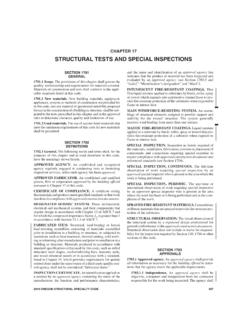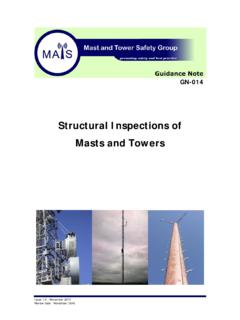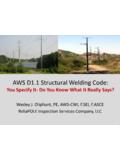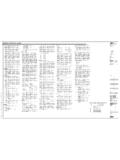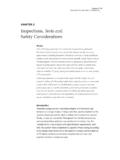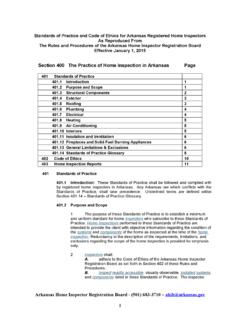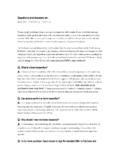Transcription of WHAT IS A STRUCTURAL INSPECTION?
1 what IS A STRUCTURAL inspection ? A STRUCTURAL - or engineering - inspection is above all, an opinion as to the STRUCTURAL condition and integrity of the building or home. That is, in the opinion of the engineer 1) were the STRUCTURAL elements (foundation, framing, etc.) designed and built to accept the anticipated loads to be placed upon them, and 2) are they continuing to perform their intended function? The ability to render such an opinion is fundamental to this definition. By law in most states, only a registered Professional Engineer is permitted to render an opinion as to the STRUCTURAL integrity of a building. Certainly others may observe and report defects (rot, cracks, etc.) but an opinion as to their significance can only be rendered by an engineer (or in some cases, an architect). It must be remembered that an opinion is not a guarantee. There are parallels in all professions. A physical performed by a doctor is not a guarantee of continued good health but an opinion as to your current condition and chances for the future.
2 Similarly, an accountant does not guarantee that your tax return will pass an IRS audit but simply does, what in his opinion, will be best. A lawyer accepts a case based on his opinion of its merits - not the certainty of success. As with the human body, there are variables in building structures that are not predictable. Soils move in a non-linear fashion. The exact time and amount of movement cannot be predicted. Wood is an imperfect material, subject to swelling, shrinkage, rot, etc. Certain loads are variable by their nature ( snow, wind). And without disassembly, many STRUCTURAL components cannot be seen during an inspection . The value of a STRUCTURAL inspection then, as in all professions, is largely dependent on the experience and qualifications of the individual who performs it. A registered Professional Engineer has, at a minimum, completed a four year accredited college program, worked for at least four years under the direction of other like professionals, and passed a 16 hour exam.
3 He or she is required by their professional code of ethics to practice only in areas competent to do so and to be accountable for the work they do. Individuals who are in private practice who are not registered (even if they have taken engineering courses) may not call themselves engineers. Criterium Engineers are registered Professional Engineers with usually at least 10 years of buildings related experience. They are trained by Criterium to provide inspections and must participate in Criterium Engineers' peer review and continuing education programs. The following pages outline in greater detail, the actual scope of a STRUCTURAL inspection . 1 STRUCTURAL ENGINEERING inspection CRITERIA For the purposes of providing inspections for relocation or other clients, the term "engineering inspection " shall apply essentially to a STRUCTURAL inspection of the building. This type of inspection can only be performed by a registered Professional Engineer.
4 PURPOSE: To determine the STRUCTURAL integrity and soundness of the building. A. FOUNDATION To be inspected: All accessible/visible portions of the foundation ( slab, floor, walls) will be examined for evidence of distress and deterioration ( cracks, movement, bowing, attachment). Report on: The significance of any distress or deterioration. Where appropriate, suggested approaches to repair including an estimated range of costs for the repairs will be provided. B. BASEMENT/CRAWL SPACE WATER To be inspected: Surface drainage conditions around the building, evidence of water entry and/or accumulation in the crawl space/basement, excessive moisture, and the presence and condition of water control systems equipment. To be reported: Description of water related conditions, adequacy of water control systems; limitations of inspection ; potential risks of water entry; approximate scope of repairs recommended, approximate cost of repairs.
5 C. FRAMING To be inspected: Investigate all accessible/visible portions of the building ( floor, ceiling, roof framing); identify wood deterioration, insect activity and/or rot and other related deterioration; visually evaluate adequacy of framing other STRUCTURAL components. Report on: Evidence of STRUCTURAL deficiencies, approximate scope of STRUCTURAL repairs required, approximate cost of STRUCTURAL repairs required. D. ROOF To be inspected: Roof surfacing, layers, flashing, sheathing (Fire Resistant Plywood), gutters for condition, type, current performance and evidence of leakage. Report on: Conditions requiring attention; and approximate cost to repair/replace. E. INTERIOR/EXTERIOR To be inspected: Examine interior and exterior of building for evidence of distress, deterioration and weather tightness (siding and windows) that might indicate conditions affecting the overall STRUCTURAL 2integrity and stability of the building.
6 Report on: Evidence of distressed or deteriorated conditions and significance of same, as well as suggested approaches to the repair including an estimated range of costs for the repairs will be provided. F. GENERAL Other items related specifically to the structure will be examined and evaluated. These may include decks, porches and other attached structures ( garages). In addition, as engineers, we have an ethical obligation to report any significant safety hazards noted during an inspection . LIMITATIONS An engineering inspection should not be construed to be any of the following: 1. A complete code compliance inspection . Such an inspection is a practical impossibility for any existing construction, since it is dependent on many things that cannot be seen, and on the status of codes that were applicable at the time the building was built.
7 2. An inspection for hazardous materials. Except in the case of obvious visual evidence of hazardous materials, an engineering inspection is not a comprehensive evaluation for hazardous materials. 3. An inspection of heating, cooling, plumbing and electrical systems. 4. A fire safety inspection (unless otherwise specifically requested). 5. A repair design. To the extent that defects are observed, approaches and related costs for effecting a satisfactory repair will be suggested. Neither the actual design of the repair nor any design drawings are included in the scope of an engineering inspection but may be provided by Criterium Engineers for an additional fee. 3 STRUCTURAL DEFECTS - what REALLY MATTERS? Are those cracks significant? That is a question often asked by our clients. Here are a few guidelines to help you distinguish between significant cracking and normal cracking. First, keep in mind that the older the building, the more likely some cracks will develop.
8 Cracks that would be considered unusual in a new building are often quite normal in an older building. By older, we are referring to a building thirty to forty years old more. Buildings less than thirty years old that develop significant cracking deserve further investigation. Such cracking often indicates other STRUCTURAL problems, not normal aging. Concrete Foundations and Slabs Concrete will almost always develop some cracking. Cracks in concrete floors that are narrow (less than 1/16 inch) and follow a random pattern throughout the floor are common and usually indicate normal shrinkage and/or marginal curing and placement of the concrete. These cracks typically do not indicate any other type of STRUCTURAL problem. As long as the floor is flush from one side of the crack to the other, the crack is probably of little or no STRUCTURAL significance. As differential movement develops, however, such that the slab on one side of the crack is significantly lower (more than 1/8 inch) than on the other side, then settlement of the soil below the slab may be occurring which deserves further investigation.
9 In certain parts of the country, particularly in the west, control joints are used on concrete slabs to help control cracking. When control joints are installed properly, random cracking is less likely to occur. The sketch at the left shows a concrete joint. Typically concrete joints should be installed in any concrete slab greater than 30 feet square. Concrete walls often develop vertical cracks that are slightly wider at the top than the bottom. This indicates some settlement in the soil under the foundation, which is common. If the crack appears more or less the same width on the inside and outside of the wall, it is typically of little concern. If, however, the crack is wider (particularly cracks that grow to 1/8 inch or more) on the inside than the outside (or not even visible on the outside), this is indicative of inward movement of the foundation wall which is often a more significant STRUCTURAL problem requiring further investigation.
10 If the wall has moved in or out such that the wall surface is not flush from one side of the crack to the other, this also indicates some movement of the wall which requires further STRUCTURAL investigation. Diagonal cracks emanating from the corner of window or door openings are also typically an indication of settlement. The size of the cracks here will indicate whether STRUCTURAL concern is warranted. Typically, cracks more than 1/8 inch wide are noteworthy. Concrete Block Foundations Cracking in a concrete block foundation will often follow a step-like pattern along the joints in the concrete block. Such cracking is common and typically does not indicate a major STRUCTURAL problem. Any cracks that would suggest inward movement of the wall, however, do deserve further investigation. Here, the same criteria as applies to concrete walls is applicable. Of particular concern in concrete block walls are horizontal cracks typically located within the upper half of the wall.
